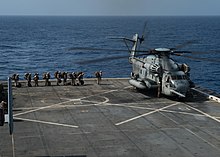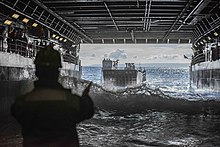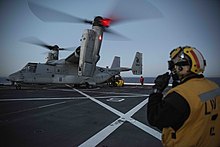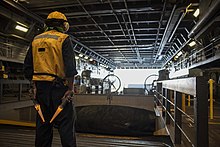USS New Orleans (LPD-18)

| |
| History | |
|---|---|
| Name | USS New Orleans |
| Namesake | The City of New Orleans, Louisiana |
| Ordered | 18 December 1998 |
| Builder | Northrop Grumman Ship Systems |
| Laid down | 14 October 2002 |
| Christened | 20 November 2004 |
| Launched | 11 December 2004 |
| Commissioned | 10 March 2007 |
| Homeport | United States Fleet Activities Sasebo |
| Motto | Victory From the Sea |
| Status | Commissioned, in active service |
| Badge |  |
| General characteristics | |
| Class and type | Template:Sclass- |
| Displacement | 24,433 tons full |
| Length |
|
| Beam |
|
| Draft | 7 m (23 ft) |
| Propulsion | Four Colt-Pielstick diesel engines, two shafts, 40,000 hp (30,000 kW) |
| Boats & landing craft carried | Two LCACs (air cushion) or one Landing Craft Utility (conventional) |
| Capacity | 700 marines (66 officers, 633 enlisted) w. surge to 800 total. |
| Complement | 33 officers, 364 enlisted |
| Armament |
|
USS New Orleans (LPD-18), a Template:Sclass-, is the fourth commissioned ship of the United States Navy to be named for the city of New Orleans, Louisiana.
History
2016 WESTPAC Deployment
On February 12, 2016, New Orleans departed San Diego for a seven-month deployment and embarked Marines from 13th Marine Expeditionary Unit (MEU), sailors from Assault Craft Unit (ACU) 1, Assault Craft Unit (ACU) 5 and Beach Master Unit (BMU) 1 as part of the Boxer Amphibious Ready Group (ARG), comprising USS New Orleans (LPD-18), USS Boxer (LHD-4) and USS Harpers Ferry (LSD-49). The first stop on deployment was in Hawaii where New Orleans conducted four days of amphibious operations bringing thousands of Marines to the beach via MV-22 Ospreys and landing craft air cushions (LCAC) for extensive sustainment training.
On March 8, 2016, USS New Orleans participated in the Ssang Yong exercise. Ssang Yong was a multinational exercise with Republic of Korea Navy and Marine Corps, Australian Army, US Navy, and Royal New Zealand Army Forces that performed a variety of military operations from disaster relief to expeditionary operations.
The next mission for New Orleans was supporting coalition operations in Fifth fleet and conducting Maritime Security Operations in the Gulf of Aden. On Jun 29, 2016, New Orleans hit a major milestone in the deployment as she anchored off the coast of Camp Buehring, Kuwait to offload nearly 1,000 tons of vehicles and machinery for an agricultural wash down, before returning to Manama, Bahrain for a mid-deployment maintenance availability.

A week later, New Orleans sailed back into 7th fleet and entered port on 25 July to visit Colombo, Sri Lanka. In this port, New Orleans had the opportunity to enhance US Navy bilateral ties with the Sri Lankan Navy, and exchange best practices on Humanitarian Assistance and Disaster Relief (HADR). The visit included several receptions, daily ship tours, sports events with Sri Lankan and US Navy/Marine Corps personnel, and HADR Training held by embarked Marines.
The Captain and Sri Lankan dignitaries cut cake during a reception on New Orleans’ flight deck In August, New Orleans made a port visit in Bali, Indonesia for a few days then shortly after stopped in Pearl Harbor, HI. New Orleans completed her WESTPAC deployment, returning to San Diego on September 16, 2016.
Maintenance Phase
On January 9, 2017, USS New Orleans moved into the Dry-dock Ships Selected Availability (DSRA) at BAE Systems shipyard. The crew and hundreds of contractors went through an extensive list of repairs and upgrades to the ship’s hull, tanks, ventilation, auxiliary, propulsion, and combat systems. After 10 months being dry docked, on November 28 New Orleans was undocked and begun preparation for work ups. Over the next six months, USS New Orleans accomplished moving the crew back onboard from the barge, Engineering Light-Off Assessment (LOA), and Combat Systems Light-Off. By mid-October, New Orleans went underway for the first time in 23 months for Contractor Sea Trials. The DSRA and the Maintenance Phase officially ended with the completion of Type Commander (TYCOM) Sea Trials in mid-November.
PACBLITZ 2019
In March 2019, New Orleans participated in Exercise Pacific Blitz 19 (PACBLITZ), an exercise that combines logistics and amphibious concepts from exercises Pacific Horizon and Dawn Blitz. PACBLITZ involved 5,000 Marines and Sailors from Marine Expeditionary Force and 5,000 Sailors spread across several installations, including Naval Base San Diego, Marine Corps Base Camp Pendleton, Marine Corps Air Station Miramar, Naval Surface Warfare Center Port Hueneme and Naval Air Station Point Mugu. The amphibious transport dock USS Somerset (LPD-25), guided-missile destroyer USS Michael Murphy (DDG-112), maritime prepositioning ship USNS William R. Button (T-AK-3012) and aviation logistics ship SS Curtiss (T-AVB-4) also participated. The exercise was three weeks long of fast paced amphibious operations where New Orleans launched and recovered multiple LCACs, AAVs, and LCUs off of San Clemente and Camp Pendleton beaches as well as MV-22 Ospreys.



Construction
The contract to build her was awarded on 18 December 1998 to Northrop Grumman Ship Systems of New Orleans, Louisiana, and her keel was laid down on 14 October 2002. The ship was christened on 20 November 2004, sponsored by Carolyn Shelton, the wife of General Henry H. Shelton, former Chairman of the Joint Chiefs of Staff. The ship was launched three weeks later, on 11 December. The ship completed her Builder's Trials on 26 October 2006.
Commissioning
New Orleans was commissioned on 10 March 2007 in New Orleans, Louisiana.[1] After commissioning, she steamed to San Diego, California via the Panama Canal to join the U.S. Pacific Fleet. The ship arrived at her new homeport of Naval Base San Diego on 3 May 2007 and was assigned to Amphibious Squadron Five.
Fielding and issues
After arriving in San Diego, New Orleans required 400,000 more man-hours of construction to bring her to fully operational status.[citation needed] In August 2008, the ship failed her INSURV inspection. The INSURV inspectors documented 2,600 deficiencies, including problems with the steering system, broken ventilation fans, inoperable elevators, corrosion on the flight deck, and an unreliable propulsion system. "USS New Orleans was degraded in her ability to conduct sustained combat operations," the INSURV report said.[1] US Navy officials reported that 85% of the deficiencies were minor issues and that most of the deficiencies had already been corrected.[citation needed]
On 9 January 2009, New Orleans departed San Diego on her initial deployment, as part of a five-ship expeditionary strike group (ESG) that also included USS Boxer and USS Comstock. The Boxer ESG and the 13th Marine Expeditionary Unit included more than 4,000 sailors and marines.[2]
Collision with USS Hartford
On 20 March 2009 New Orleans was involved in a collision with the attack submarine USS Hartford in the Strait of Hormuz. Fifteen sailors on Hartford suffered minor injuries and the fuel tank on New Orleans was ruptured causing an oil spill of 25,000 gallons of diesel marine fuel. After the incident both vessels were able to continue under their own power.[3]
References
- ^ Liewer, Steve (1 October 2008). "Troubles in port, at sea weigh down Navy ship". San Diego Union-Tribune. Retrieved 2 January 2008.
- ^ Fuentes, Gidget (13 January 2009). "13th MEU departs San Diego for deployment". Marine Corps Times. Retrieved 18 August 2009.
- ^ "Two U.S. Navy Vessels Collide in the Strait of Hormuz". Commander, US Fifth Fleet. 20 March 2009. Archived from the original on 23 March 2009. Retrieved 20 March 2009.
History
- "US navy vessels collide in Gulf" (News report). BBC News. United Kingdom: British Broadcasting Corporation. 20 March 2009. Retrieved 20 March 2009.
